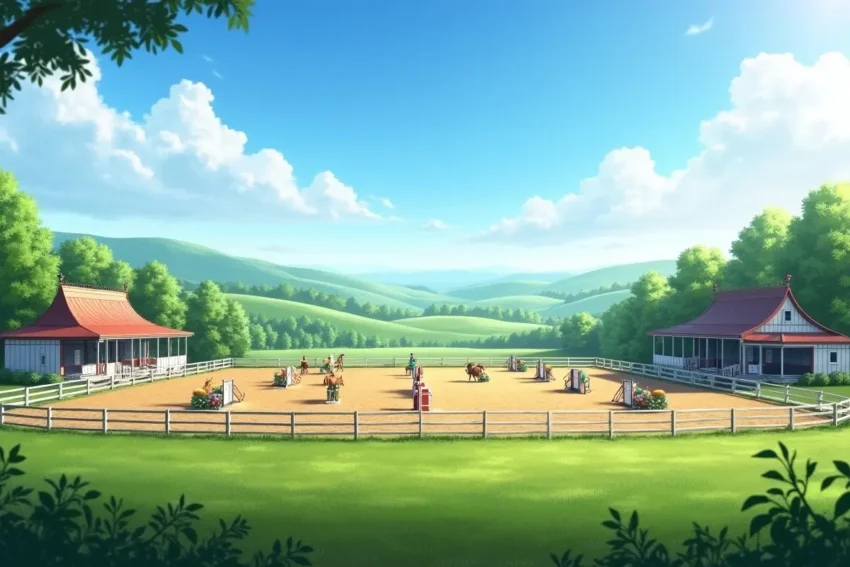Designing a horse jump arena that strikes a balance between safety and efficiency is crucial to the health and performance of both horse and rider. The right arena setup can make all the difference in developing equestrian skills and preventing injuries. From ideal footing to carefully chosen jumps and space management, every detail has an impact. Whether you’re building a new arena or upgrading an existing one, investing in professional equestrian jump equipment enhances your arena’s functionality and safety for horses at any training level.
Meticulous maintenance routines, well-planned storage solutions, and adaptable training aids characterize safe and efficient arenas. Jump materials, arena boundaries, and special features should all work together to minimize risks. By understanding and implementing these foundational elements, equestrians can create a training environment that supports continuous improvement while protecting both the horse and the rider.
A horse arena setup should be a dynamic environment, adapting to training needs, weather fluctuations, and evolving safety standards. Effective management not only extends the longevity of the arena itself but also fosters confidence in those who use it. Prioritizing the best practices for arena construction, upkeep, and layout is a crucial investment in the future success of your stable.
In this guide, you’ll find actionable strategies for developing an arena that promotes optimal training outcomes and encourages consistent safety standards. The following sections cover everything from footing selection and jump design to regular inspections and smart storage practices.
Arena Footing: The Foundation of Safety
The safety and effectiveness of a horse jump arena start at ground level. Quality footing provides the necessary traction and shock absorption, helping to prevent injuries from slips, trips, and excessive wear on joints. Arena surfaces should be level, resilient, and appropriate for the types of activities performed—jumping demands a different footing mix than dressage or pleasure riding. Sand and fiber blends are common, but consult with an equestrian surface expert to ensure your footing matches both your climate and use requirements.
Routine maintenance, including harrowing and watering, is crucial to maintaining a reliable riding surface. Dust suppression matters not only for visibility but also for respiratory health. Protecting the underlying arena base from erosion or excessive moisture will prolong the surface’s lifespan. More information on arena footing best practices can be found in this overview by Horse Illustrated.
Jump Design and Placement
Jumps should be designed with the safety of both horse and rider at the forefront. Using breakaway cups for poles and selecting materials that absorb impact minimizes the risk of injury. Varying jump types and heights provides comprehensive training without overfacing the horse. Strategic placement helps riders develop rhythm and balance while safely progressing in skill level. Always ensure sufficient space between obstacles to prevent crowding and allow for safe approach and recovery.
Variety and Versatility
Incorporate different jump types, such as verticals, oxers, and combinations, to challenge horse and rider in various ways. Modular jumps can be rearranged to create new courses, preventing both horse and rider from becoming bored or complacent.
Regular Maintenance and Inspections
An effective maintenance schedule supports both the longevity and safety of your horse jump arena. Footing should be checked daily for uneven areas, potholes, or the onset of dust issues, especially after periods of heavy use or rain. Jumps should be inspected for splinters, stability, and hardware integrity. Faulty or deteriorating jump standards and poles should be removed immediately. Arena fencing and any entry gates must be kept in good repair to prevent escape or collisions.
Incorporating Safety Features
Additional safety elements can be integrated into your arena design to help prevent serious incidents. Flexible jump cups, clear boundary markers, and properly padded standards protect the horse in the event of a refusal or misstep.
The perimeter of the arena should allow a buffer zone—at least 3-5 feet from the edge to the fences or barriers. Gated entries should open outward and remain locked when not in use. Emergency access routes for vehicles and first responders are another critical consideration for high-use or competition arenas.
Weather Considerations
Climate plays a major role in arena planning and upkeep. Installing a thorough drainage system keeps the surface rideable during rainy spells, while windbreaks or shade structures make training sessions more comfortable and productive. Some arena footings, such as synthetic blends, perform better in fluctuating moisture levels or cold snaps. In humid climates, regular removal of organic debris prevents hazardous mold growth. These provisions extend usability year-round and safeguard your arena’s investment.
Efficient Equipment Storage
Clutter-free arenas are safer and save everyone valuable time during setup and takedown. Designate a well-organized area outside the active training space for jump standards, poles, and other gear. Wall racks, storage sheds, and mobile equipment caddies help keep everything in order and reduce trip hazards within the arena. Consider weatherproof storage for jump cups and related accessories to prevent wear and ensure quick access.
Utilizing Training Aids
Training aids can supplement the main course and support targeted skill development. Ground poles and cavaletti help young or green horses develop rhythm and confidence over obstacles. Advanced aids, such as bounce grids or raised cavalletti, fine-tune agility and adjustability for more seasoned competitors. Rotate training aids regularly to match your current goals and keep both horse and rider engaged.
Conclusion
A safe and efficient horse jump arena is an ongoing project that requires proactive management and thoughtful upgrades. Commitment to quality footing, intentional jump layout, and strategic storage solutions underpins every successful training session. By emphasizing these priorities and embracing continuous improvement, equestrians can create a space that supports the growth, safety, and enjoyment of both horse and rider for years to come.

